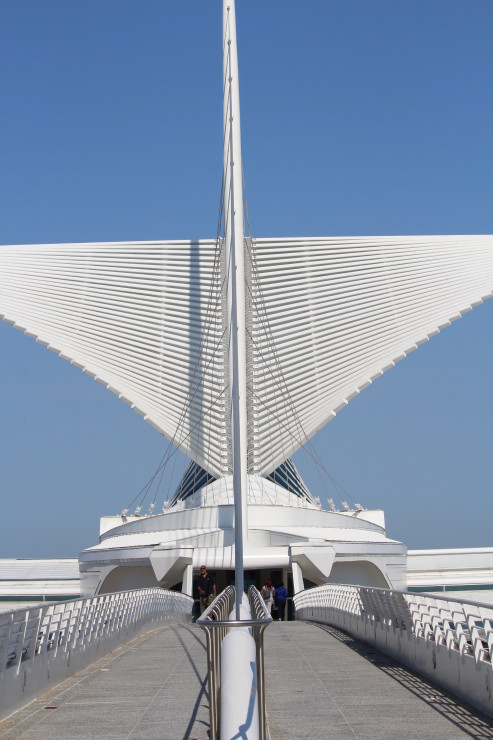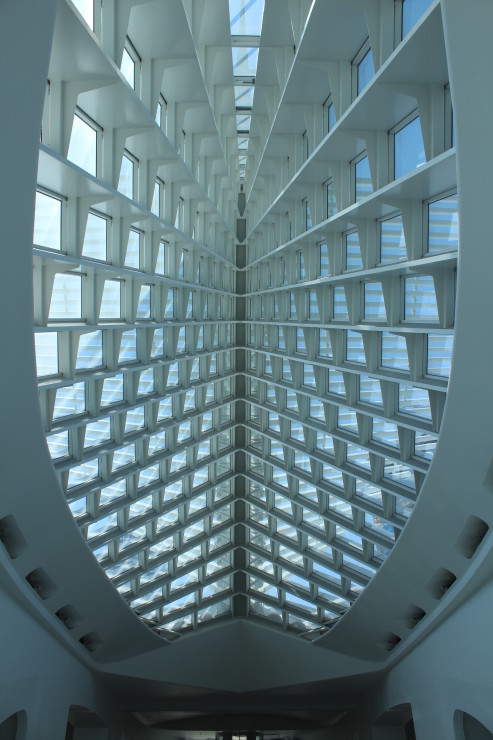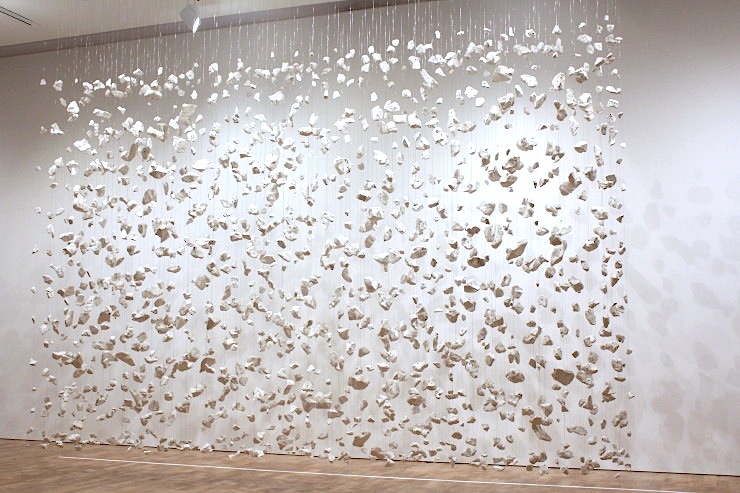I make sure I arrive at the right time to see the Milwaukee Art Museum’s rooftop open its wings. Or are they waves?
Nestled on the shores of Lake Michigan, the museum houses 30, 000 pieces of art, but the structure is an attraction all its own. The “Brise Soleil, ” a rooftop addition completed in 1991 and designed by Santiago Calatrava, slowly opens its 72 steel fins, ranging in length from 26 to 105 feet, to a wing span comparable to that of a Boeing 747-400. When fully extended, the museum looks like it’s about to either set sail or fly away.
I head toward the ship. Or maybe now it’s a whale? Or a bird? Different angles suggest different possibilities. The wings unfold and fold twice daily, and I’ve arrived in the morning to tour the collections for the day, as well as watch the wings unfold.

Pedestrian Bridge to Museum
It seems strange that I would find myself here, an Indian-born, Alabama-raised girl, living in Milwaukee. But maybe it does make sense, after all, because the word “Milwaukee” is an Algonquin word, “millioki, ” which means “gathering place by the waters.” Many did gather; the city’s summer festivals celebrate its Irish, German, Polish and Italian heritage, as well as its Latino, African-American and Asian communities. Just as the city has gathered people from all over the world, in the late 1880s, Frederick Layton opened an art gallery to gather art from around the world. The collection grew, and in 1957 the Layton Art Gallery collection moved to its current location on the lake, where marbled waves cradle the shore.
Once inside, either via the long pedestrian bridge from downtown or through the front entrance, a beautiful, airy, large atrium with 90-foot ceilings encapsulates the visitor. A popular photo spot, a colorful glass balloon-like sculpture by Chihuly greets visitors near the entrance.

Atrium Ceiling
Extending off this main atrium, heading north, the visitor is ushered along white marble hallways leading to the main galleries. Waves crash along the building’s concrete edge, and if you choose to exit to the south, you’ll stroll outside, adding fresh air and a vista of the lake and city to your viewing pleasure. Art by the lake? Yes, please.
Objects are divided into painting and sculptures, photographs and videos, prints and drawings, and decorative art. Choose one of the four floors to observe works of antiquity to modern art. The variety appeals to my curiosity, and as I wander its halls, I see firsthand how art gathers and unites people from all walks of life. The day I’m visiting, I hear several languages as people react and interact with various paintings: a scene from Ancient Rome, a sunset illuminating the side of a mountain, a lion facing a sunset, ladies chatting on a sunny afternoon outdoors. These are moments and stories all cultures connect with.
Many of the walls are white, bare, like the white winter sky. In winter, snow and ice break up on the water’s edge, creating a mix of reality and wonder for the visitor absorbed in the halls of paintings while water pounds nearby. In summer, the clear blue sky and lake shimmer, with many folks strolling nearby, drinking in the warmth of the season.
While wandering, I see an artist here or there painting a replica of one of the paintings on display. Classes are held on site, as well as special exhibitions, fairs, shows, or even weddings.
The museum boasts one of the largest Georgia O’Keefe collections, along with Monet’s serene Waterloo Bridge, Sunlight Effect, Andy Warhol’s Campbell’s Soup (1965), and the lesser-known Egyptian Mummy Coffin of Pedusiri. Visitors can admire works by Winslow Homer, Auguste Rodin, Edgar Degas, Pablo Picasso, Joan Miró, Botticini, Groningen, Pissaro, Gaugin, and Durer, to name a few. I am especially intrigued by Cornelia Parker’s Edge of England, a large frame filled with pieces of chalk and rock fragments from the Dover Cliffs in England. It looks like a rugged, beaded curtain—or a snowstorm. It seems at home here.

Cornelia Parker’s Edge of England
In this diverse collection, from a mummy, to sculpture and video art, one of the most popular pieces to see is, believe it or not, the janitor—a realistic, life-size janitor sculpture, that is.
Duane Hanson’s Janitor (1973) is dressed in a blue shirt, looking down, hunched over a bit, leaning slightly. He doesn’t look visitors in the eye. Maybe he’s shy. Or simply tired. He’s been moved to various spots around the museum, doing his duty, I suppose. Presumably, he’ll never get to retire, and that’s probably okay with the museum curators, as he’s quite popular.
Heading back to the main pavilion, I glance at the massive lake outside, a medium wind creating short, choppy waves with a tuft of white at the crest. With the waves to the side and the wings open above, I get a sense of change and motion, but the art inside offers a sense of stability and unity: the unity of who we are as people, our human condition, which various artists have expressed through diverse means. The roof reminds me I don’t have to look down, like the janitor. Instead, I look up and observe possibilities take flight.
Featured photo by David Kim Photography, Creative Commons, via Flickr. Other museum photos courtesy of the author. Post by Prasanta Verma.
_____________________________
Subscribe to our free weekly newsletter.
We’ll make your Saturdays happy with a regular delivery of the best in poetry and poetic things.
Need a little convincing? Enjoy a free sample.
- Regional Tour: Grohmann Museum – Milwaukee School of Engineering (MSOE) - September 2, 2016
- Regional Tour: Milwaukee Art Museum - June 10, 2016


Maureen says
A remarkable building. Love the “Love of England” installation.
Thank you, Prasanta. Good to see you here.
Maureen says
And of course I meant “Edge of England”.
Prasanta says
It is quite a building, isn’t it?
Thank you, Maureen. It is a joy and privilege to be here!
Bethany R. says
Thank you for taking us on this tour, Prasanta! Love this: “Waves crash along the building’s concrete edge, and if you choose to exit to the south, you’ll stroll outside, adding fresh air and a vista of the lake and city to your viewing pleasure. Art by the lake? Yes, please.” Such a fun and contemplative voice throughout.
The Janitor sculpture you mentioned here brought to mind another scultpure by Duane Hanson: Slab Man. It was featured in Dolly Lee’s Regional Tour piece of the Cantor Arts Center at Stanford University. Great to learn about two pieces by the same artist (at least I’m assuming it is the same Duane Hanson) in different venues. Just for fun I’ll leave the link below.
https://www.tweetspeakpoetry.com/2015/03/13/cantor-arts-center-stanford-university-palo-alto-ca/
Prasanta says
I think it must be the same artist! I see some similarities between Slab Man and Janitor (both are life-size, realistic, ordinary people, etc.). Thank you for the reminder of this! I enjoyed the paintings highlighted and Dolly’s article.
Thank you for the encouragement and commenting, Bethany!
Bethany says
How cool! Fun to know you see similarities. 🙂 Thanks again for this piece, Prasanta.
Rick Maxson says
Prasanta, I enjoy your poetry and prose very much. This piece with your words and the photographs of David Kim made me want to go there immediately and someday I will.
Thank you for the experience of touring with you.
Prasanta says
Rick, thank you, and I must also say the same – how much I enjoy your poetry and prose.
When you do visit, give a holler!